14 Types of Farm Vehicles: Everything You Need to Know
Aug 15th 2024
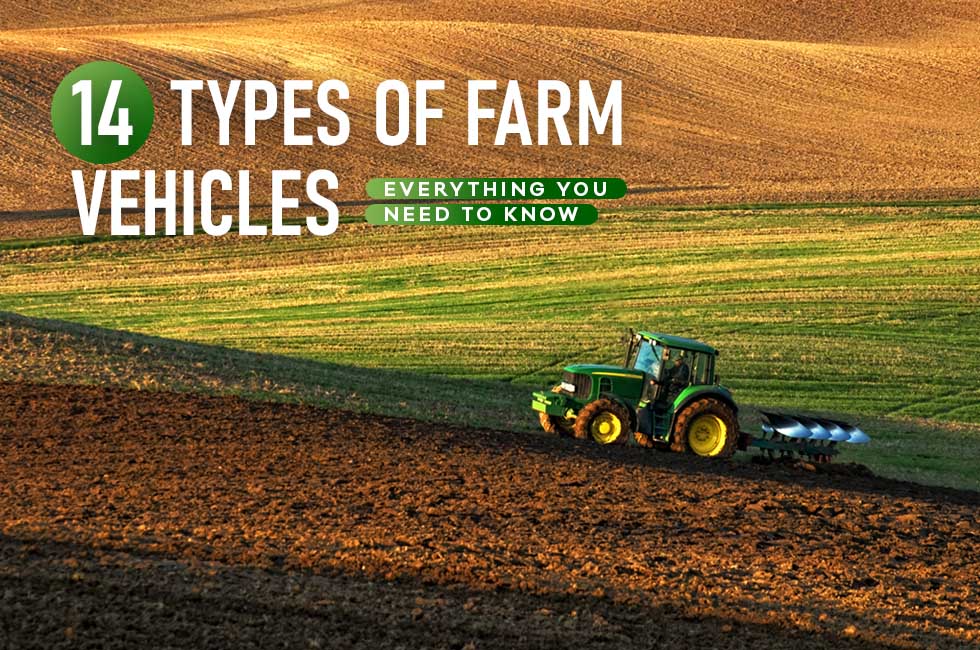
Farming has evolved from back-breaking work in the sun to sitting behind the wheel of a tractor or truck. Today’s vehicles can comb dozens of acres in a fraction of the time it would take growers to reach by hand or mule. As technological developments increase efficiency and output, the global demand for food only grows.
Agricultural machines are getting larger and more powerful to help companies maximize yield amid the warming climate. Hauling all that weight requires diesel vehicles and diesel products, which is more efficient than gas. Learn about the different types of farm vehicles and how they help feed the world.
The Evolution of Farm Vehicles
Farmers have long invented ways to simplify and accelerate their operations using some of the earliest examples of mechanical engineering. In 1701, Jethro Tull created the seed drill, which combined a small plow with a container of seeds to complete two tasks simultaneously, saving precious time and energy. Early devices could be drawn by hand or horse. Steam-powered engines further increased efficiency in the 1800s, finally replacing humans and animals. Hefty tanks powered moving belts and hoses to process the grain, but these vehicles were difficult to transport and hazardous.
Rudolf Diesel’s invention of the internal combustion engine propelled the global agricultural industry to new heights at the dawn of the Industrial Revolution as the population increased rapidly. John Froelich used the technology to build the first gas-powered tractor in 1892. However, this mechanical boon wasn’t widely available until Henry Ford created and mass-produced the Fordson, which ran on kerosene.
During the Great Depression, the farming industry needed to boost production without raising prices. After creating the first motorized field grader in 1931, Caterpillar soon emerged as the leading manufacturer of diesel engines. The original prototype combined several components into a single machine for leveling dirt before planting.
Farmers and equipment manufacturers recognized diesel’s ability to move heavy objects from rest or at low speeds, also known as low-end torque. Each barrel of fuel contained more energy than gasoline. Diesel is more stable than its counterpart and handles well under various conditions. Compressing air and fuel to trigger combustion instead of a spark plug reduces wear and tear and simplifies equipment maintenance.
The Future of Farm Vehicles
The spirit of innovation in farming lives on today. Companies are pushing this technology to engineer larger machines capable of covering more ground in less time. That often means increasing the weight of each vehicle. A typical combine harvester for grain now weighs nearly 79,000 pounds, a ten-fold increase from the late 1950s, and it can cover 30 acres in an hour.
However, all those extra pounds can damage soil nutrients and affect the ground’s ability to store carbon. More experts are advocating for smaller interconnected vehicles that don’t limit the potential for future crop growth. Labor shortages and extreme heat are pushing the industry toward autonomous farm equipment, so the crew doesn’t have to be outside during the hottest hours of the day.
Every action can produce crucial insights into the farm’s productivity. The latest machines have sensors that monitor output during harvesting, crop conditions and completion times to help administrators make informed decisions instead of waiting to count their yield at the end of the harvest.
Demand for farm vehicles remains strong as the developing world modernizes farming operations. The global market value for agriculture equipment is expected to grow from $107 billion in 2023 to $136 billion in 2028.
Types of Farm Vehicles
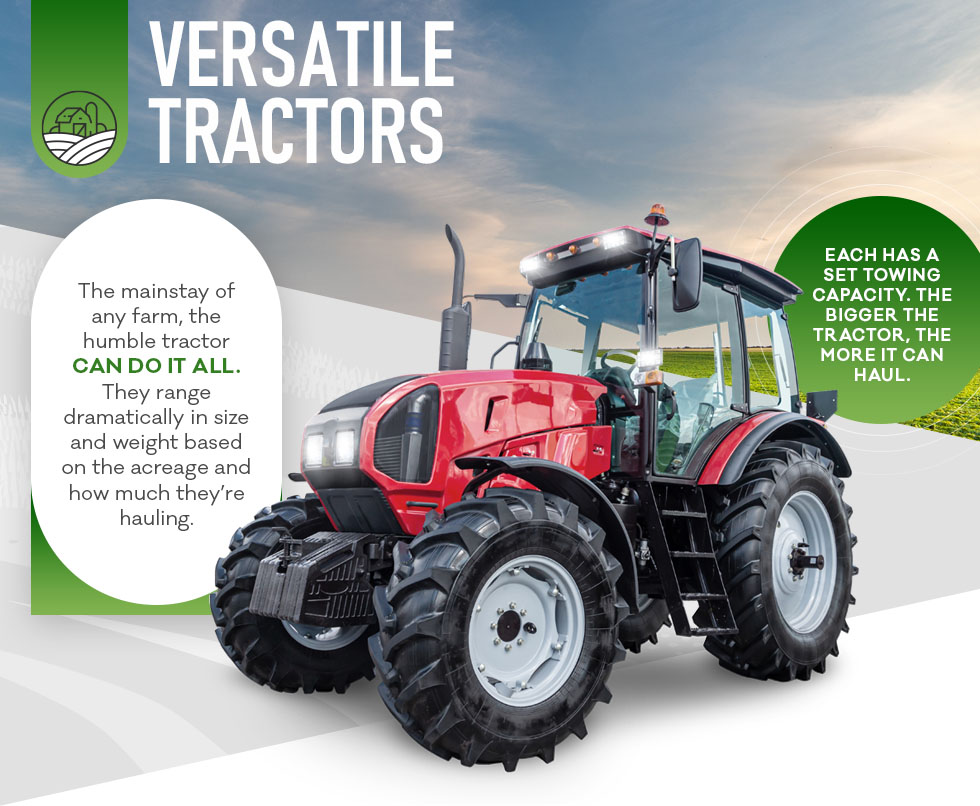
1. Tractors
The mainstay of any farm, the humble tractor can do it all. They range dramatically in size and weight based on the acreage and how much they’re hauling. Each has a set towing capacity. The bigger the tractor, the more it can haul. Compact tractors expose the rider to the elements; utility and farm tractors have enclosures and sit higher off the ground. Larger models have tracks instead of off-road tires to distribute the weight, reduce vibrations and increase power.
With the right attachments, tractors can be extremely versatile. Small and independent farms can use one vehicle for seeding, fertilizing, tilling, towing, plowing, mowing, harrowing, raking and baling.
2. Combine Harvesters
Combine harvesters cut, thresh and winnow grains in one swift motion. They’re used to harvest wheat, corn, barley, sorghum, oats, sunflower, rice and soybeans. Rotating gears grab the crop and push it toward a blade, where it gets cut and pressed into a drum. The non-edible portions fall to the ground via a conveyor belt or are bagged for disposal. The width of the harvester determines how much ground it can cover. Farmers would have to cut and separate the edible portion by hand without this marvel of machinery.
3. ATVs
Compact off-road vehicles, such as ATVs, UTVs, quads and four-by-fours, transport workers and smaller quantities of supplies across the property. They are faster, smaller and more efficient than tractors. Farmers can quickly get from one end of the field to another without tramping through their crops.
ATVs fit one passenger, while UTVs can transport up to eight. They have off-road tires and limited towing capacities for attaching a wagon or trailer. Some can also be converted into mowers, seeders and spreaders.
4. Spreaders
Spreaders are fitted with tanks filled with gallons of fertilizer, manure or pesticides. They can distribute solids and liquids and release small portions as they move over the crops to give each plant an even coat. However, solid manure needs to be broken up by a harrow.
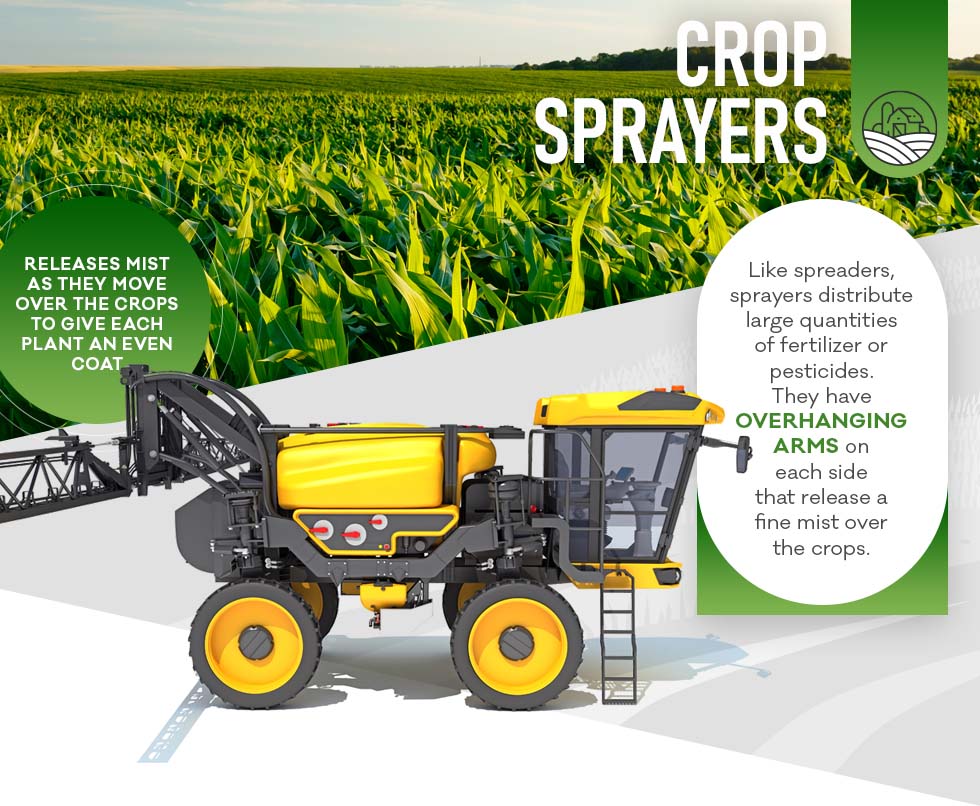
5. Sprayers
Like spreaders, sprayers distribute large quantities of fertilizer or pesticides. They have overhanging arms on each side that release liquids as a fine mist over the crops.
6. Loaders
Loaders have plows on the front for pushing and gathering debris. The front trough is connected to two moveable arms that can raise and dump whatever’s inside. They help farmers clear debris and gather crops or barrels of hay.
7. Seeders
Seeders distribute seeds over vast swaths of land. They hold large quantities of seeds in a drum and use various methods to plant them in the ground. Broadcast seeders simply release the seeds at limited, continuous intervals — usually over grass — and let gravity and nature do their jobs. Air seeders use compressed air to shoot the seeds into the ground. Drill seeders drill the seed into the ground. Planters dig a small hole, plant the seed and then cover it with dirt.
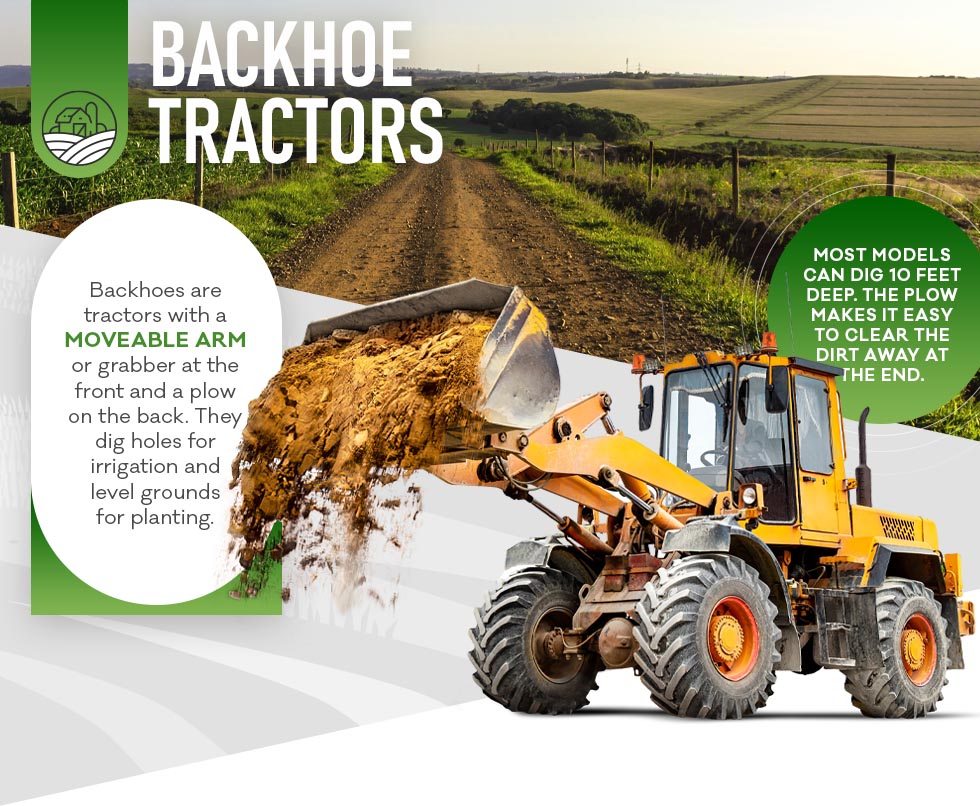
8. Backhoes
Backhoes are tractors with a moveable arm or grabber at the front and a plow on the back. They dig holes for irrigation and level grounds for planting. Most models can dig ten feet deep. The plow makes it easy to clear the dirt away at the end.
9. Balers
Balers wrap hay, straw and corn into easily moveable bales. It scoops up the stalks and puts them on a conveyor belt. They’re bundled together with twine, netting or wire before depositing it on the ground. The front has a loader for gathering the bales and plowing loose stalks into neat rows.
10. Cultivators and Tillers
Tillers have blades for cutting, mixing and aerating the soil to increase oxidation. Cultivators aerate the soil before planting and remove weeds from the field before or after planting. They have metal teeth that grab and uproot the weed plant and may even bury the leaves to stop them from growing.
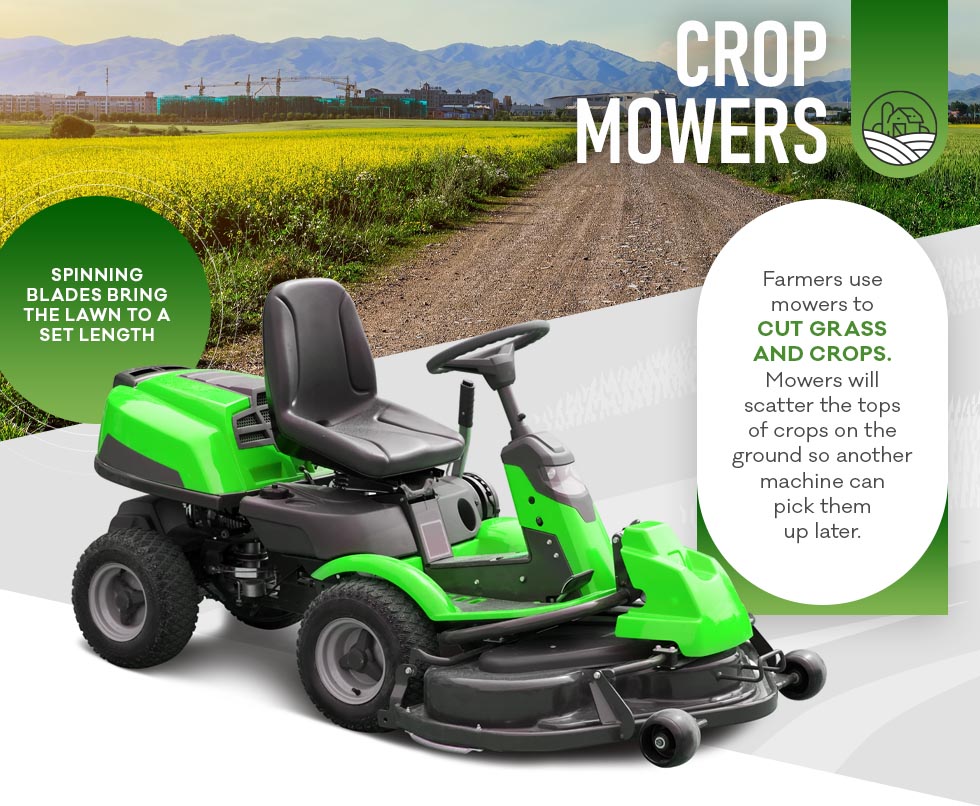
11. Mowers
Farmers use mowers to cut grass and crops. These vehicles have spinning blades to bring the lawn to a set length. Mowers will scatter the tops of crops on the ground so another machine can pick them up later.
12. Orchard Cabs
Orchard cabs are all-terrain vehicles with a low profile and round metal bars on top that allow them to drive smoothly under trees. They transport pickers through the orchard without catching branches and often have storage containers on the back for collecting produce. Certain models have enclosures that can be heated or cooled in the winter or summer.
13. Levelers
Levelers flatten large sections of dirt using a rolling pin. They remove uneven sections that can snag farm equipment. Clearing the way also makes for a smoother rider.
14. Pickup Trucks
The great American pickup truck can double as farm equipment. It can be lifted and fitted with off-road tires to trek through dirt, mud and snow. Farmers use the bed to carry supplies and can attach a trailer for more storage space. They can also attach a plow, seeder, spreader or sprayer to the back. Interested in industrial machines? Learn about the different types of construction vehicles and how to maintain them.
Shop All of Our Diesel ProductsMaintenance for Farm Vehicles
Farmers regularly schedule maintenance for their vehicles to optimize performance and limit downtime. A mechanical failure could bring operations to a halt at a crucial point in the harvest cycle. Diesel vehicles need regular oil changes to increase lubrication and pressurize the fuel before it enters the combustion chamber. However, excess heat and long hours on the field can contaminate the oil, spreading debris throughout the system.
The valve gasket cover seals the oil on the cylinder head in the engine to prevent leaks and contamination. A collision and high temperatures can break the seal, rapidly reducing pressure. The engine will lose power and efficiency as smoke starts to billow out from under the hood. Check and replace the valve gasket cover often to lock the oil in place.
Leaving fuel in storage for months at a time can lead to water separation, increasing the risk of oxidation. Metal particles can clog the fuel injectors, limiting how much fuel can enter the combustion chamber. If the nozzle fails to open, the engine will misfire. Clean and replace damaged fuel injectors to maximize fuel efficiency and power. The fuel tank and pump may be contaminated with debris and should be replaced.
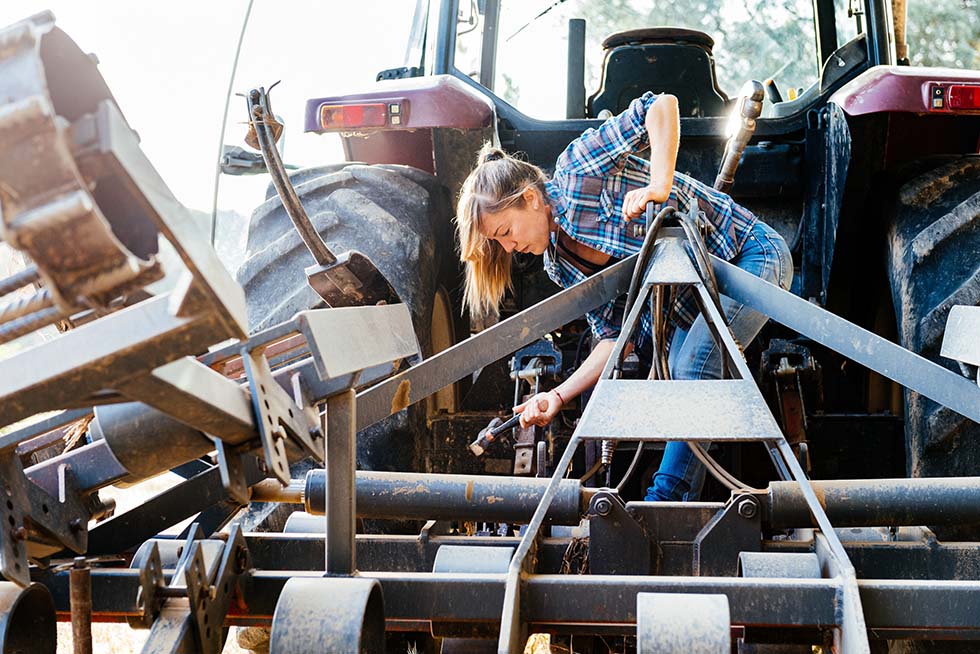
To reduce the spread of debris, store fuel in clean containers when not in use and insulate it from temperature changes when not in use. The battery will steadily lose power over its lifespan, especially in the winter. To protect the battery from the cold, keep equipment indoors or use a battery warmer to insulate the terminals. Check the voltage regularly and replace aging units to power electrical components.
Many diesel vehicles have turbochargers that force more compressed air into the engine to increase acceleration. The turbo air intake valve filters out debris. However, excess dirt, dust and crop remains can clog this vital passageway and break the turbo actuator, limiting boosting power and fuel efficiency. Replace the turbo actuator to avoid wasting fuel.
Farming has changed considerably since the invention of the diesel engine. Today’s vehicles can move tens of thousands of pounds and cover dozens of acres in the span of a few minutes to put more food on tables in less time. Earth will only have more mouths to feed in the coming years, putting more pressure on farmers to increase their yield. The industry will continue engineering equipment that maximizes productivity while dealing with a changing climate.
Image Credits
Borderline Artistic/Shutterstock.com
Olga Strel/Shutterstock.com
Dushlik/Shutterstock.com
Fotokostic/Shutterstock.com
Another77/Shutterstock.com
Andrea Cirillo Lopes/Shutterstock.com
Creative Travel Projects/Shutterstock.com
BearFotos/Shutterstock.com
3D-Horse/Shutterstock.com
ABCDstock/Shutterstock.com
Svend77/Shutterstock.com
Galdric PS/Shutterstock.com
